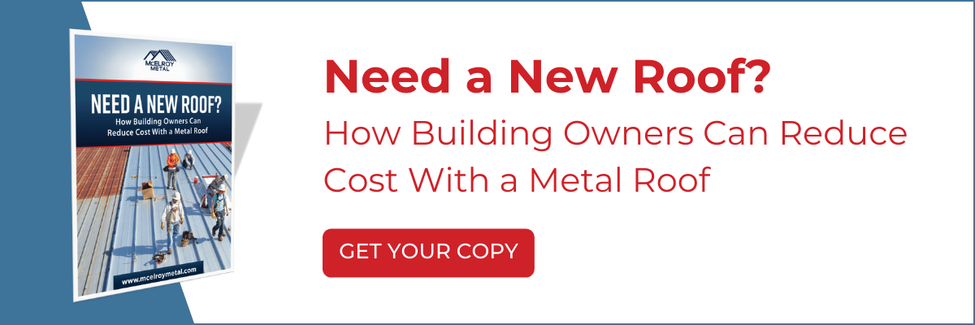What Are the Advantages of Metal Over Other Commercial Roofing Materials?
Commercial building owners understand the importance of a quality roof to protect inventory, equipment, and staff. They also typically possess a keen sense of costs and return on investment.
While the hard costs of roofing material and labor are easy to spot, the soft costs of roof replacement also bear consideration. While certainly not exhaustive, the high-level list below illustrates just how quickly the soft costs of roof replacement accumulate.
- Schedule Roof Inspection
- Review Inspection Report
- Compare Repair vs. Replace Costs
- Decision to Pursue Replacement
- Research/Select Material Options
- Request Roof Replacement Estimates
- Develop Replacement Budgets
- Evaluate Ongoing Repairs vs. Replacement
- Review Tax & Financial Data
- Recommendation to Replace Roof
- Gain Approval for Roof Replacement
- Make Finance Arrangements
- Request Bids from 2-3 Contractors
- Compare Bids and Statement of Work
- Request Revised Bids
- Check Installer Credentials
- Select Installer
- Review/Approve Statement of Work
- Ensure Installer Insurance Coverage
- Project Management Efforts Before & During Replacement
- Move Equipment & Operations as Necessary
- Lost Time Due to Interruption to Daily Operations
- Lost Revenue
When considering the time each step above requires, it is no surprise that commercial building owners are beginning to emphasize roof longevity over the lowest initial installation cost.
Metal roofing offers several unique advantages compared to other roofing materials, with longevity being one of the biggest. Below we outline the pros and cons of some of the most popular commercial roofing options for commercial, industrial, and architectural projects.
Common Architectural/Commercial/Industrial Options
- Cost-effective
- Durable and flexible
- Energy efficient (white reflective surface)
- UV- and fungi-resistant
- Lightweight and easy to install
- Improved long-term track record in the U.S. market
- Ongoing maintenance required
- Quality and performance vary by manufacturer
- Can be slippery when wet
- Highly durable
- Excellent chemical resistance
- Strong resistance to wind, fire, UV, and water
- Energy efficient and recyclable
- Performs well in harsh environments (restaurants, industrial buildings
- Higher upfront cost than TPO or EPDM
- Foot traffic can still cause damage in cold temps, though less than in older versions
- Repairs can be more challenging
- Low cost
- Fire & weather resistant
- Proven long-term performance
- Easy to install and repair
- Available in white for improved reflectivity
- Recyclable
- Requires periodic maintenance
- Can shrink over time, stressing seams and flashings
- Black membranes absorb heat unless reflective versions are used
- Very durable and impact-resistant
- Fire resistant
- Walkable surface
- Simple to repair
- Very heavy, may require structural reinforcement
- Slower installation process
- Susceptible to wind uplift
- Declining popularity compared to membranes
- Fumes during installation
- Proven, widely used system
- Flexible in varying temperatures
- Easy to install
- Resists foot traffic better than some membranes
- Dark surfaces absorb heat
- Torch-applied systems carry fire risks
- Limited tolerance for ponding water
- Prone to surface damage from impacts
- Reduces heat island effect
- Improves stormwater management
- Enhances energy efficiency
- Adds green space and improves air quality
- Fire resistant
- High upfront cost
- Heavy—requires structural support
- Requires ongoing specialized maintenance
- Permitting and codes vary by location
- Longest life expectancy among roof systems
- 100% recyclable, sustainable choice
- Can lower heating/cooling costs by 10–25%
- Excellent durability and fire resistance
- Lightweight and can often be installed over an existing roof
- Low maintenance
- Wide range of architectural styles and finishes
- Insulated Metal Panels (IMPs) combine the durability of metal with a foam core for exceptional energy efficiency, quick installation, and modern aesthetics—all while maintaining the longest life expectancy of any roofing option discussed.
- Higher upfront cost
- Requires skilled installation
- Noise perception if not insulated properly (usually mitigated in modern systems)
Ultimately, the best roofing option for you depends on factors like budget, appetite for the time and work involved with each roof replacement, the architectural style of your project, local climate, and personal preferences.
If we can be of any help as you weigh options, don’t hesitate to contact us. We’re always here to help!
About McElroy Metal
Since 1963, McElroy Metal has served the construction industry with quality products and excellent customer service. The employee-owned components manufacturer is headquartered in Bossier City, La., and has 14 manufacturing facilities across the United States. Quality, service and performance have been the cornerstone of McElroy Metal’s business philosophy and have contributed to the success of the company through the years. As a preferred service provider, these values will continue to be at the forefront of McElroy Metal’s model along with a strong focus on the customer.



.png?width=767&name=What%20to%20Expect%20When%20You%20Order%20From%20McElroy%20Metal%20(1).png)


.png?width=440&height=293&name=How%20to%20Install%20Metal%20Roofing%20Over%20Existing%20Metal%20Roofs%20(1).png)


Comments on this article:
Scroll down to the bottom to submit a comment and join the conversation. Need help or have a question? Please contact us. Looking for a distributor or contractor? Please click here to get started.